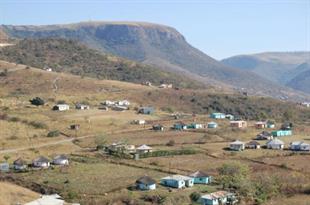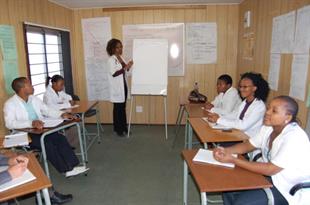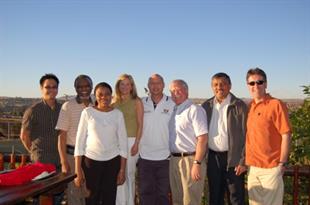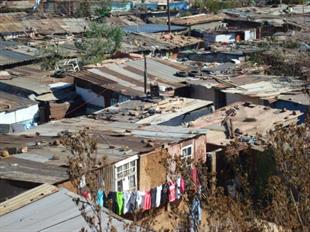Creating a Health Care Profession in South Africa
 The clinical associate program, as the South Africans call it, is expected to play a huge role in a country with vast rural areas and an AIDS epidemic.
The clinical associate program, as the South Africans call it, is expected to play a huge role in a country with vast rural areas and an AIDS epidemic.
Anita Glicken, MSW, director of the University of Colorado medical school’s CHA/PA program, went to South Africa in late May. She met with counterparts from Walter Sisulu University in the Eastern Cape province.
We asked her to keep a journal of her experiences along with those of two colleagues—Jonathan Bowser, PA, and Dr. Cal Wilson, director of the Center for Global Health.
It’s a story of careening cars, croaking birds and the effort to create a new health-care profession in a country that desperately needs help.
 Sunday, May 30
Sunday, May 30
The flight from Johannesburg to Mthatha takes us over the rolling brown hills of the Drakensberg Mountains to the land that nurtured anti-apartheid leaders Walter Sisulu and Nelson Mandela. This journey is exciting—not just because World Cup soccer is about to arrive—and a bit daunting. Three Colorado medical school teachers are on their way to help launch a new profession in South Africa.
The province where we will be working is the poorest in the country, which overall has a doctor-to-population ratio of eight per 10,000—less than a third that of the United States (by the World Health Organization’s count). Of the children who die before age 5, some 45 percent are killed by HIV/AIDS; here it is a primary-care issue. We’ve come to learn about the people, their needs, their lives—and then to figure out how to take this new profession forward.
Things are different here: a night sky with the Southern Cross, a bird (Jon says it’s a scops owl) that sounds like a frog, a bright yellow and black spider the size of a child’s hand that stands like a sentinel at the gates of the Palm Lodge—our home for the week. Each morning I am awakened by the smells of breakfast at 5:00. There is a strong Internet connection, but our host has never learned the password, so we’ve lost our tether to the outside world.
Monday, May 31
We pass gates and security guards as we enter Sisulu’s campus to meet with Health Sciences Dean Khaya Mfenyana. He’s remarkable—a man devoted to public health who presides over a school that is a prime mover for community-based training with a strong service foundation. His vision pushes community health and the university’s involvement to new levels—water systems, sanitation, health education.
We bring a spirit of enthusiasm, partnership
 Tuesday, June 1
Tuesday, June 1
The cars the university lends us have screechy sirens that erupt above
South Africa launched this effort three years ago in three locations. Sisulu’s is the farthest along. Its first 19 students graduate this fall. In Mount
The students wear white coats. They have nicknames, as do the faculty. One student was "Queen Bee" and a physician tutor was affectionately called "Muso," which translates in Xhosa to "benevolent god." The work here is largely conducted in English because most of the faculty are from other countries and don’t speak Xhosa, a language marked by clicking sounds.
The recently built hospital is incredibly clean and smells new, more like a new hotel than a place of pain and care in an area where the life expectancy is about 45 years. There are 245 patient beds spread over a one-story building. The scene in the pediatrics ward was moving. Four kids, who appeared malnourished, lay in beds. Seated next to each child was the mother, head down on the bed, sleeping.
Wednesday, June 2
 The healthcare system here begins with clinics in far-flung towns. These feed into their district hospitals, which feed to regional academic medical centers. Most clinical associates will work in
The healthcare system here begins with clinics in far-flung towns. These feed into their district hospitals, which feed to regional academic medical centers. Most clinical associates will work in
As we make our rounds, the staff members are warm but cautious; they clearly care deeply for the masses of patients that line the rooms. In contrast, right next door is the bright, shiny regional academic center, reserved for the sickest patients. Is it worth getting sicker to be transferred into the new academic hospital?
In rural areas like this, people still hike miles for water, carrying it home in plastic jugs and buckets. Some families have an outhouse on the property. That’s a big improvement over the alternative, which was nothing. It’s now clear that given the rural nature and poverty of the Eastern Cape, it's not surprising that the public healthcare system is weak and
Thursday, June 3
The next morning we drive to St. Barnabas, a district hospital in Libode. They are just beginning to keep medical records here such as birth certificates. In a country lacking vital statistics, it’s hard to track patient outcomes and evaluate practice.
We enter a room with walls covered by beautiful, hand-painted murals. It’s a children’s playroom donated by a foreign charity. Yet the toys are stacked unused in a closet; the room is used for sleeping mothers and children too sick to play. The clinical associate students here ask the same questions as their peers in other facilities: "What about salaries?" "Will we always work in the hospital?" "Do you like being a physician assistant?"
We then get back in the car to drive to a nearby clinic in Mgwenyane, a small town surrounded by the round huts typical of the Eastern Cape. Here, as in other parts of rural South Africa, many families grow what they eat. But things are changing. For those living closer to small towns, supermarkets have sprung up and the people walk to buy chips and soda, which leads to a predictable increase in heart disease and diabetes. Even in this rural clinic, you can see the effects of AIDS—once a week, patients line up to get their antiretroviral drugs. Friday, June 4
Time set aside for visioning about the new profession. When they graduate, almost 80 percent of the medical students from outside the area leave for Johannesburg, Cape Town or international posts. Those from the area tend to stay but gravitate to private practice. Clinical assistants are expected to stay, building capacity in the Eastern Cape where their strong family bonds and government-sponsored posts tie them to the region. Although they will start out supporting doctors in district hospitals, we expect they ultimately will do much more to improve quality and access to care throughout South Africa.
Saturday, June 5
 A colorful journey to the coast and Port St. Johns. The hillsides along the way are sprinkled with huts in blue, green, orange, yellow—each color marking a family group. Along the
A colorful journey to the coast and Port St. Johns. The hillsides along the way are sprinkled with huts in blue, green, orange, yellow—each color marking a family group. Along the
Sunday, June 6
Where do we go from here? We meet with AIHA staff and Walter Sisulu faculty to talk about next steps. Our partners will come to Denver in December to see our program, meet with others on campus including our PA grads. The first task when I return is to work on a research proposal to evaluate the impact of CAs in South Africa, particularly on HIV-AIDS. Partnering will allow them to build research capacity at Sisulu.
 Monday, June 7
Monday, June 7
Early flight to Jo’burg. A late-morning meeting with the Center for Disease Control (CDC-South Africa). Before we return, a stop in Soweto, the former black township, where kids play soccer on any flat land and men wearing white smocks sit in chairs on the side of the road getting hair and beards trimmed by the local barber. A small boy makes a house out of cardboard boxes emptied of World Cup treasures. Tourists haggle with locals over the price for a plastic vuvuzela.
Tuesday, June 8
On the plane home. I left with more questions than answers. Will our South African partners allow us to contribute? Will we have the fortitude and wisdom to make informed choices as we learn to trust our work together? Generations of history and beliefs create obstacles to the growth of this new profession. My purpose: to turn these challenges into opportunities.
For all the differences, there are many similarities: problems of access in rural areas, lack of trust across the professions, working with a cohort of colleagues and students who do what we do. My head is exploding—new experiences, knowledge, visions for the future … a new window for viewing our work together and our potential role. Our shared goal is clear: to bring health care to those who need it here and abroad.